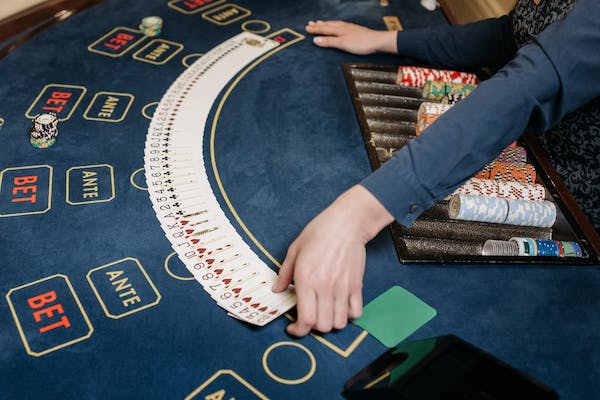Friendly poker tournaments are a popular way to enjoy the game of poker in a competitive setting among friends or acquaintances. These tournaments provide an opportunity for players to showcase their skills, strategize, and have a great time together. To ensure fairness and a smooth gameplay experience, it is essential to establish clear and agreed-upon rules. In this guide, we will outline the basic rules for a friendly poker tournament, including how to play and increase your chances of winning. Whether you are a seasoned player or new to the game, these rules will help you navigate the tournament and enhance your poker skills.
Understanding the Basic Rules of a Friendly Poker Tournament
Friendly Poker Tournament Rules: How to Play and Win in a Competitive Setting
In a friendly poker tournament, players compete against each other to accumulate chips and ultimately be the last player standing. The game is typically played with a standard deck of 52 cards and can accommodate anywhere from two to ten players. Each player is dealt a certain number of chips at the beginning of the tournament, and the goal is to win as many chips as possible from your opponents.
The tournament progresses through a series of hands, with each hand consisting of several rounds of betting. The two players to the left of the dealer are required to place mandatory bets called the small blind and the big blind, respectively. These bets ensure that there is always money in the pot and encourage players to participate actively in the game.
Once the blinds are posted, each player is dealt two private cards, known as hole cards. These cards are only visible to the player who receives them and form the basis of their hand. After the hole cards are dealt, a round of betting takes place, starting with the player to the left of the big blind.
Following the first round of betting, the dealer places three community cards face-up on the table. This is known as the flop. These community cards can be used by all players to form their best possible hand. Another round of betting occurs, with players having the option to check, bet, call, raise, or fold.
After the flop betting round, the dealer reveals a fourth community card, known as the turn. This is followed by another round of betting. Finally, the dealer reveals the fifth and final community card, called the river. A final round of betting takes place, and if there are still two or more players remaining, a showdown occurs.
During the showdown, each player reveals their hole cards, and the player with the best hand wins the pot. In the event of a tie, the pot is split equally among the tied players. The tournament continues with new hands until only one player remains with all the chips, declaring them the winner.
It’s important to note that in a friendly poker tournament, certain rules may be modified or agreed upon by the players before the game begins. These modifications can include variations in betting limits, the number of chips each player starts with, or even the specific poker variant being played.
Understanding the basic rules of a friendly poker tournament is crucial for a successful and enjoyable experience. By familiarizing yourself with the flow of the game, the different betting rounds, and the hierarchy of poker hands, you’ll be well-equipped to compete in a competitive setting. So gather your friends, sharpen your skills, and get ready for an exhilarating poker tournament where the stakes are high, and the rewards are even higher.
Tips and Strategies for Winning in a Friendly Poker Tournament
First and foremost, it’s important to understand the rules of the game. While there are many variations of poker, the most common one played in tournaments is Texas Hold’em. Each player is dealt two private cards, and then five community cards are placed face-up on the table. The goal is to make the best five-card hand using any combination of the seven cards available. Understanding the ranking of hands is crucial, as it will determine who wins each round.
In a friendly poker tournament, it’s essential to maintain a friendly and respectful atmosphere. Remember, the goal is to have fun and enjoy the game with friends. Avoid trash-talking or gloating when you win a hand, as this can create tension and spoil the experience for others. Instead, focus on playing your best game and appreciating the skill and strategy of your opponents.
One strategy that can greatly improve your chances of winning is to observe your opponents closely. Pay attention to their betting patterns, body language, and reactions. This information can give you valuable insights into their hand strength and help you make better decisions. For example, if a player suddenly becomes more aggressive, it could indicate that they have a strong hand. On the other hand, if a player seems hesitant or unsure, they may be bluffing.
Bluffing is an essential skill in poker, but it should be used sparingly and strategically. Bluffing involves making your opponents believe that you have a better hand than you actually do. This can be done by betting aggressively or by displaying confidence through your body language. However, bluffing can backfire if your opponents see through it, so it’s important to choose your moments wisely.
Another important aspect of winning in a friendly poker tournament is managing your bankroll effectively. Set a budget for yourself and stick to it. It’s easy to get caught up in the excitement of the game and start betting more than you can afford. Remember, poker is a game of skill and luck, and even the best players can have losing streaks. By managing your bankroll responsibly, you can ensure that you can continue playing and enjoying the game without risking financial strain.
Lastly, always be willing to learn and improve your skills. Poker is a game that requires constant practice and study. Read books, watch tutorials, and analyze your own gameplay to identify areas for improvement. Discuss strategies with fellow players and learn from their experiences. The more you invest in your poker skills, the better your chances of winning in a friendly poker tournament.
In conclusion, winning in a friendly poker tournament requires a combination of skill, strategy, and a friendly attitude. By understanding the rules, observing your opponents, bluffing strategically, managing your bankroll, and continuously improving your skills, you can increase your chances of coming out on top. Remember, the most important aspect of a friendly poker tournament is to have fun and enjoy the company of your friends. So, gather your chips, shuffle the cards, and may the best player win!
Etiquette and Sportsmanship in a Friendly Poker Tournament
Etiquette and Sportsmanship in a Friendly Poker Tournament
In any competitive setting, whether it be a sports event or a friendly poker tournament, etiquette and sportsmanship play a crucial role in ensuring a fair and enjoyable experience for all participants. While the primary objective of a poker tournament is to win, it is equally important to maintain a respectful and friendly atmosphere throughout the game. This article will delve into the key aspects of etiquette and sportsmanship that should be observed in a friendly poker tournament, providing players with the necessary guidelines to enhance their playing experience.
First and foremost, it is essential to treat all players with respect and courtesy. Regardless of skill level or experience, every participant deserves to be treated fairly and without prejudice. Avoid making derogatory comments or engaging in disrespectful behavior that may create a hostile environment. Remember, a friendly poker tournament is meant to be a social gathering where players can enjoy the game and each other’s company.
Furthermore, it is crucial to maintain a positive attitude, regardless of the outcome of each hand. Winning and losing are both part of the game, and it is important to accept both outcomes gracefully. Avoid displaying excessive emotions, such as anger or frustration, as this can create tension and spoil the atmosphere for others. Instead, focus on enjoying the game and appreciating the skills and strategies of your opponents.
Another important aspect of sportsmanship in a friendly poker tournament is honesty and integrity. Cheating or attempting to gain an unfair advantage is not only unethical but also undermines the integrity of the game. Always play by the rules and avoid any actions that may be considered dishonest, such as hiding cards or colluding with other players. Remember, the true essence of a poker tournament lies in the challenge and excitement of playing a fair game.
In addition to honesty, it is crucial to respect the rules and decisions of the tournament organizers and dealers. They are responsible for ensuring a smooth and fair gameplay experience for all participants. If you have any concerns or disagreements, address them in a respectful manner and follow the proper channels for resolving disputes. Avoid arguing or causing unnecessary disruptions that may disrupt the flow of the game.
Furthermore, it is important to be mindful of your behavior and actions at the table. Avoid distracting or disturbing other players by talking excessively or engaging in unrelated activities. Maintain a reasonable level of noise and avoid any disruptive behavior that may hinder the concentration of others. Remember, a friendly poker tournament is a shared experience, and it is important to be considerate of others’ needs and preferences.
Lastly, always remember to congratulate and show appreciation for your opponents’ achievements. Whether they win a hand or the entire tournament, acknowledging their success demonstrates good sportsmanship and fosters a positive atmosphere. Celebrate their victories and offer words of encouragement when they face setbacks. Remember, a friendly poker tournament is not just about winning; it is about building connections and enjoying the game together.
In conclusion, etiquette and sportsmanship are vital components of a friendly poker tournament. Treating all players with respect, maintaining a positive attitude, and playing with honesty and integrity are essential for creating a fair and enjoyable environment. By adhering to these guidelines, participants can enhance their playing experience and contribute to a memorable and friendly poker tournament. So, gather your friends, follow the rules, and let the cards fall where they may – may the best player win!
Common Mistakes to Avoid in a Friendly Poker Tournament
Common Mistakes to Avoid in a Friendly Poker Tournament
When it comes to playing poker in a friendly tournament setting, it’s important to remember that even though the atmosphere may be relaxed, the competition can still be fierce. To ensure that you have the best chance of coming out on top, it’s crucial to avoid some common mistakes that many players make. In this article, we will discuss these mistakes and provide you with tips on how to avoid them.
One of the most common mistakes that players make in a friendly poker tournament is playing too many hands. It can be tempting to want to be involved in every hand, especially when the stakes are low and the atmosphere is casual. However, this can quickly lead to losing chips and ultimately being knocked out of the tournament. It’s important to remember that in poker, quality beats quantity. Only play hands that have a good chance of winning and fold the rest.
Another mistake that players often make is failing to pay attention to their opponents’ actions and betting patterns. In a friendly tournament, it’s easy to get caught up in the social aspect and lose focus on the game. However, paying attention to how your opponents are playing can give you valuable information about their hand strength and help you make better decisions. Take note of their betting patterns, their reactions to certain cards, and any other tells they may have.
A common mistake that can cost you dearly in a friendly poker tournament is not managing your bankroll effectively. It’s easy to get carried away and bet more than you can afford to lose, especially when the stakes are low. However, it’s important to set a budget for yourself and stick to it. Don’t let the relaxed atmosphere fool you into making reckless bets. Remember, even in a friendly tournament, every chip counts.
Another mistake that players often make is failing to adjust their strategy as the tournament progresses. In the early stages, it’s common to play more aggressively and take risks. However, as the tournament progresses and the blinds increase, it’s important to tighten up your play and be more selective with your hands. Don’t be afraid to fold if you don’t have a strong hand. Patience and discipline are key to success in a poker tournament.
Lastly, one of the biggest mistakes that players make in a friendly poker tournament is letting emotions get the best of them. It’s easy to get frustrated or angry when things don’t go your way, but it’s important to stay calm and composed. Making impulsive decisions based on emotions can lead to costly mistakes. Remember, poker is a game of skill and strategy, not luck. Stay focused and make rational decisions based on the information available to you.
In conclusion, playing in a friendly poker tournament can be a fun and exciting experience. However, it’s important to avoid common mistakes that can cost you the game. Remember to play only quality hands, pay attention to your opponents, manage your bankroll effectively, adjust your strategy as the tournament progresses, and keep your emotions in check. By avoiding these mistakes, you’ll greatly increase your chances of winning in a competitive setting. Good luck!
How to Organize and Host a Successful Friendly Poker Tournament
Organizing and hosting a friendly poker tournament can be a thrilling and rewarding experience. Whether you are a seasoned player or a novice, this article will guide you through the process of setting up a successful event that will leave your guests wanting more.
First and foremost, it is essential to establish the rules of the tournament. This will ensure fairness and clarity for all participants. Begin by determining the buy-in amount, which is the entry fee each player must pay to participate. It is crucial to set a reasonable buy-in that is affordable for all players, as this will encourage more people to join.
Next, decide on the structure of the tournament. Will it be a single-table event or a multi-table tournament? Single-table tournaments are ideal for smaller gatherings, while multi-table tournaments can accommodate larger groups. Additionally, determine the blinds structure, which is the minimum bet that increases at regular intervals. This will keep the game moving and prevent players from stalling.
To ensure a smooth flow of the tournament, assign a dealer for each table. The dealer’s role is to shuffle and distribute the cards, as well as manage the betting rounds. It is crucial to select experienced dealers who are familiar with the rules and etiquette of poker. This will help maintain a professional atmosphere and prevent any disputes from arising.
Furthermore, establish the payout structure for the tournament. How will the prize pool be distributed among the top finishers? Common payout structures include awarding the majority of the prize pool to the winner, with smaller amounts for the runners-up. Alternatively, you can distribute the prize pool among the top three or four players, providing a more balanced payout.
In addition to the rules and structure, consider the logistics of hosting the tournament. Ensure you have enough tables, chairs, and poker chips for all participants. It is also essential to provide refreshments and snacks to keep everyone energized throughout the event. Consider creating a comfortable and inviting atmosphere by dimming the lights and playing some background music.
To attract more participants, promote your tournament through various channels. Utilize social media platforms, such as Facebook and Twitter, to spread the word. Additionally, create flyers and distribute them at local poker clubs or game stores. Word of mouth can also be a powerful tool, so encourage your friends and family to invite others who may be interested.
On the day of the tournament, arrive early to set up the tables and ensure everything is in order. Greet your guests warmly and provide them with a brief overview of the rules and structure. Encourage friendly competition and remind everyone to respect the game and their fellow players.
Throughout the tournament, maintain a professional and impartial demeanor. Address any disputes or concerns promptly and fairly. Remember, the goal is to create a fun and enjoyable experience for all participants.
In conclusion, organizing and hosting a friendly poker tournament requires careful planning and attention to detail. By establishing clear rules, creating a comfortable atmosphere, and promoting the event effectively, you can ensure a successful and memorable experience for all involved. So gather your friends, shuffle the cards, and let the games begin Friendly poker tournament rules provide a structured and competitive setting for players to enjoy the game. By following these rules, players can enhance their skills, strategize effectively, and increase their chances of winning. It is important to maintain a friendly atmosphere, adhere to fair play, and respect the rules and decisions made by the tournament organizer. With practice and experience, players can improve their gameplay and have a rewarding experience in a friendly poker tournament.




